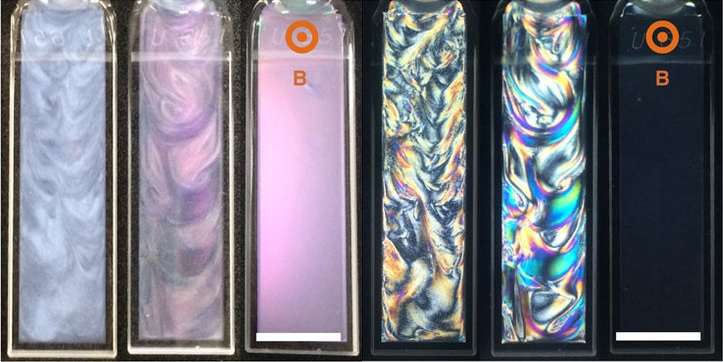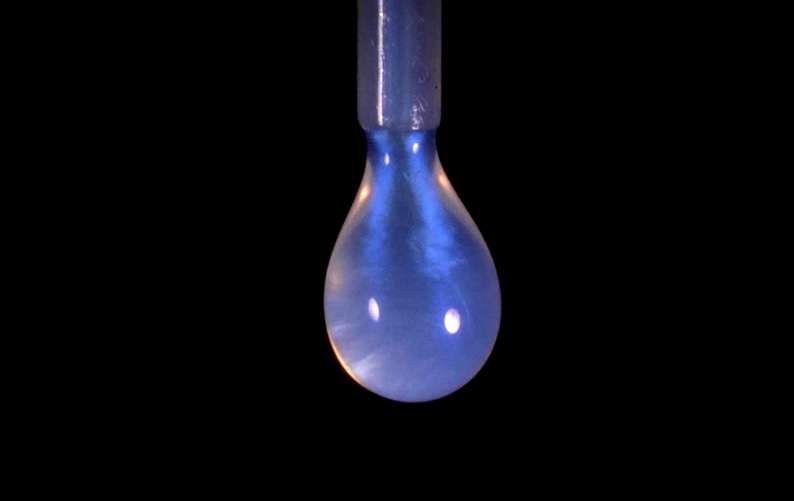September 21, 2016 feature
Color-changing water reflects a rainbow of colors and beyond

(Phys.org)—Scientists have created a water-based mixture that rapidly changes color when exposed to a variety of stimuli, such as a change in magnetic field, temperature, or pH. The scientists call the mixture "photonic water," and it can reflect any color of the visible spectrum, as well as parts of the ultraviolet and infrared regions. This color-modulation range is the widest that has ever been reported for any material, either solid or liquid.
The researchers, Koki Sano et al., from various institutions in Japan, have published a paper on the photonic water in a recent issue of Nature Communications.
"Our photonic water realizes two seemingly contradictory features: fluidity and order," coauthor Yasuhiro Ishida at the RIKEN Center for Emergent Matter Science in Saitama, Japan, told Phys.org. "This is quite different from the generally conceived notion that photonic materials should be composed of hard materials."
The researchers stumbled upon the unique mixture somewhat by accident when they were attempting to separate certain particles based on size. Although those experiments were unsuccessful, the scientists were surprised to find that, when placing one of the products in water, the water turned a vivid purple color.
Investigating further, the scientists found that the colorful mixture displays both fluidity and order, which seems contradictory because fluids are typically very disordered. But the new mixture has the unusual property that it is highly ordered, like a crystal structure. Further, the periodic distance (the distance between repeating units) is extremely large, up to 675 nm. This separation corresponds to a reflection wavelength of 1750 nm (in the infrared region), and when tuned appropriately, the fluid can reflect light across the entire visible spectrum, which consists of wavelengths from approximately 400 to 700 nm. The reflection range also extends down to 370 nm, in the ultraviolet region. This range of 370 to 1750 nm is the widest color-modulation range that has ever been reported for any photonic, or "light-modulating," material.

How does the fluid reflect all of these colors? As its name suggests, photonic water is mostly ordinary water: it is more than 99.5% water by volume. The remaining 0.5% contains the "active ingredients," which are titanate nanosheets and quaternary ammonium (Q+ ions). When added to water, these ingredients don't dissolve like salt or sugar, but instead remain intact, like sand in water. The non-dissolving particles are called colloids, and when dispersed in water, they form what's called a colloid dispersion—but one that is unlike any other colloid dispersion known so far.
The uniqueness of the new colloid dispersion comes from its long periodic structure, as mentioned above, which in turn arises because the colloid is highly electrically charged. The titanate nanosheets have a very strong negative charge, so that the 0.75-nm-thick sheets strongly repel each other. Normally, this repulsion is greatly reduced by a cloud of positively charged Q+ ions in the quaternary ammonium that surround the titanate nanosheets. The Q+ ions effectively screen much of the negative electrostatic repulsion between the titanate nanosheets.
However, the scientists found that, by removing some of the Q+ ions through centrifuging (the process by which they were originally trying to separate the colloids based on size), the colloidal dispersion turns purple. Without the Q+ ions to screen the repulsion, the titanate nanosheets spread themselves as far apart as possible. As a result, the entire fluid becomes highly structured, with long periodic distances that cause the fluid to reflect long wavelengths of light. In contrast, ordinary water lacks this highly ordered, long-period structure, and so it reflects light with wavelengths that are much shorter than those in the visible range, making it transparent.
The researchers demonstrated that the color of the photonic water can be rapidly and reversibly changed by placing the colloidal dispersion in a strong magnetic field, which causes the titanate nanosheets to align perpendicularly to the field. Similarly, heating and cooling the photonic water changes the separation distance between nanosheets, and therefore the color. Even small changes in pH cause the color to change from red (7.9) to green (7.7) to blue (7.3), again due to changing the electrostatic repulsion and therefore the structure and color of the photonic water.
In general, photonic materials that reflect light in the near-infrared range have important applications in telecommunications, although they are currently very difficult to fabricate. Photonic water may have potential uses in this area and others.
"Considering the stimuli responsiveness and the wide-range color modulability, our photonic water may find various applications as smart optical devices, including optical sensors and displays, near-infrared band filters for telecommunications, variable photonic lasers, etc.," Ishida said.
The researchers expect that the results will have applications beyond fluids, as well. For example, the method they established here for enhancing the electrostatic repulsive forces between titanate nanosheets can be applied to titante nanosheets that they recently developed into soft materials with unique functions due to their internal electrostatic repulsion.
Extending even beyond titanate nanosheets, the researchers hope that the surprising discovery of photonic water will "breathe new life into the traditional field of colloidal sciences."
"Not only for titanite nanosheets, but also for other colloidal systems, the enhancement of electrostatic repulsive forces would have a large impact on the physical properties of these materials," Ishida said.
More information: Koki Sano et al. "Photonic water dynamically responsive to external stimuli." Nature Communications. DOI: 10.1038/ncomms12559
Journal information: Nature Communications
© 2016 Phys.org



















